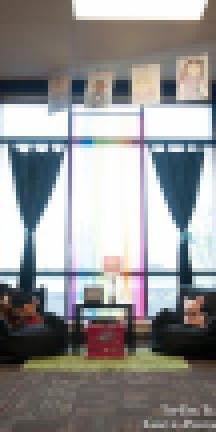It’s been my dream to make my 2nd grade classroom look more like a “Starbucks for kids”, and less like, well, a classroom.
Think about when you go to Starbucks to complete some work. Why do you choose to work there? Where do you choose to sit? I usually gravitate towards the comfy seating choices like the couches and big chairs, and yet, I see people choose the tables and chairs over and over again. Regardless, when you walk into Starbucks, you have choice. You get to choose where you sit. No one checks you in and directs you to a spot, telling you that you must sit there for the remainder of the day to do your work. If you need to get up, walk around, or choose a different seat, you are free to do so.
As I sat in our local Starbucks this past summer, I looked around and thought—why can’t my classroom look like this?
After several weeks of planning and a little bit of faith, what resulted was this:


But how did I get to this point? Let me take you through some common questions I get asked about classroom redesign—so that hopefully, you can do the same.
What did your process look like?
Before I even purchased a single thing, I thought about why I was doing a classroom redesign. If we truly want to prepare our students for the real world, we need to put them in responsive, dynamic environments that reflect life outside of a traditional classroom. And what’s that life outside like? Full of choices, where adults are responsible for their own learning. As a college student visiting my classroom once said, “It’s like you’re treating them like little adults.” And as my teaching has changed, my classroom design needed to change right along with it.
After consulting Erin Klein, a classroom design guru who has been “ditching her desks” to avoid “the cemetery effect” for a few years now and sharing her experiments on her blog, I thought about my classroom and the traditional chairs and tables I was given—and I came up with a plan.
Looking around my classroom, I quickly realized that I had far too much furniture, so I got rid of four tables, my huge teacher desk, 20 traditional chairs and a file cabinet. Next, I started looking for resources to redesign and repurpose what I already had. I looked around my house and in my storage closet to pull some pieces that I wasn’t using, and scavenged Hobby Lobby for some new purchases.
What came out of that was flexible seating and open floor space: I thought about my students who would prefer to stretch out on the floor, and I purchased yoga mats and bath rugs for them to lay out on and work. Simultaneously, my fellow educators contributed extra clipboards they weren’t using so students would be able to write just as easily.
Now, I have a large, open area for whole group instruction and five remaining tables, each designed with a specific purpose:
- a small group instruction whiteboard table with stools
- a stand-and-work table with no chairs
- a crate seats table
- a sit-on-the-floor area with core disks or pillows and work table (see to the right)
- a stability ball chairs table
Do you have a seating plan or arrangement?
No, I don’t have a seating plan for kids. I allow students to responsibly choose where they work every day. When they arrive in the morning, they make a choice for the day but are free to switch places as they see fit throughout the day. I have enough seating options in our classroom that there are never issues about running out of one type of seating.
How do you ensure students are selecting smart choices to work?
At the beginning of the year, students spent an entire day trying out each of the seating choices. After that, I began to let them self-select their seating daily.
I think this is an important step in the process. For example, one student who stands and works originally swore up and down that he would work best on the stability balls—but that changed. It only took him falling off the chair once and almost bouncing out the door for us to both realize that it probably wasn’t a smart fit for him.
One big note: Students know I always reserve the right to move them, and they know I always have their best learning in mind.
What about your students with behavior issues?
The behaviors of my students who have exhibited aggressive or distracting behaviors in the past have significantly decreased. There is power for them in the choice to select where they will work. They know the work isn’t optional, but choosing where they work is.
Did you do it all at once, or introduce these changes slowly over time?
I had the option of “work rugs” (glorified bath rugs, as shown to the right) for students last year, but only a few students utilized them. So, things have changed over time.
If you want to just try a few things without breaking the bank, I would start with a few work rugs or yoga mats. Or, just take the legs off of a table, lay it on the ground and get some cheap pillows for students to sit on. It’s also easy to raise a table for students who prefer to stand and work. Don’t feed the fears—just try it and see what works for you.
Where do students keep materials?
We have work bins in the corner of our room where students keep folders, math journals, and other personal items. We use community supplies at each of the five tables, and I have individual baskets of supplies for students that choose to work on yoga mats or work rugs. If you don’t have work bins for students, get three drawer stackers and place them throughout the room, or put materials in baskets. You may have to get creative and repurpose something you already have—or something that another teacher has, but isn’t using.
What do parents think of all this?
This was an amazing question I saw on my Instagram page, and it pushed me to reach out to a parent for an opinion for this article. Here was her response:
“From a parenting perspective, I have really enjoyed the flexible seating option Mrs. Delzer has offered this year. When I was able to observe the seating options in her classroom, it just really made a lot of sense to me... meeting the kids’ needs and also allowing them the responsibility and flexibility to choose where they will learn best for the day. My daughter has come home just thrilled at the opportunity to choose where she sits and it appears to help her focus when she isn’t expected to sit in a chair for long stretches of the day.”—Lorraine Albrecht
If we take a look at classrooms over the past 70 years, we are seeing the same type of learning environments, year after year. The world is changing, yet our classrooms are remaining much the same. Revitalizing space is a straightforward way to let students exercise choice in the learning environment and find academic success on their own terms.
Now several weeks into our school year, I can’t imagine going back to traditional seating. Distracting behaviors have been almost completely eliminated while engagement and student participation are at an all time high. And as I look around our classroom, I feel proud of what we have accomplished—a Starbucks for kids.


